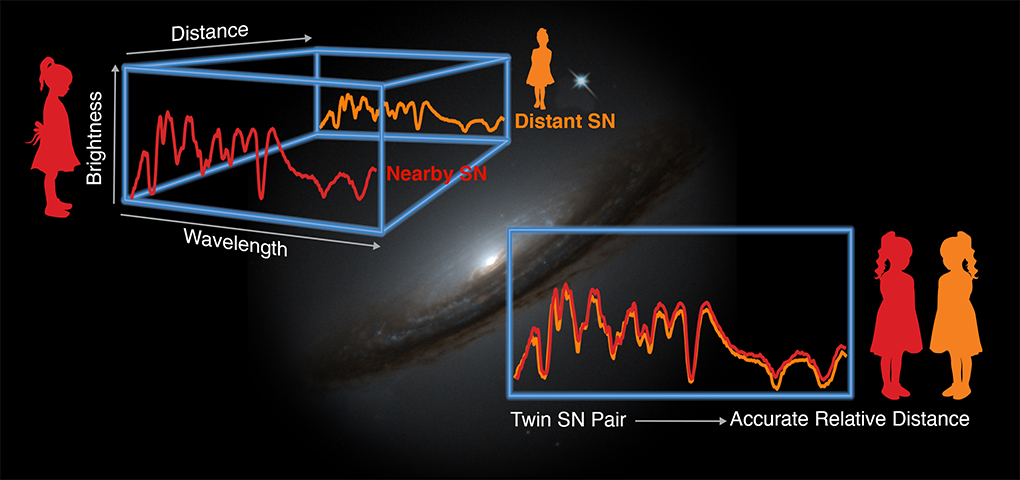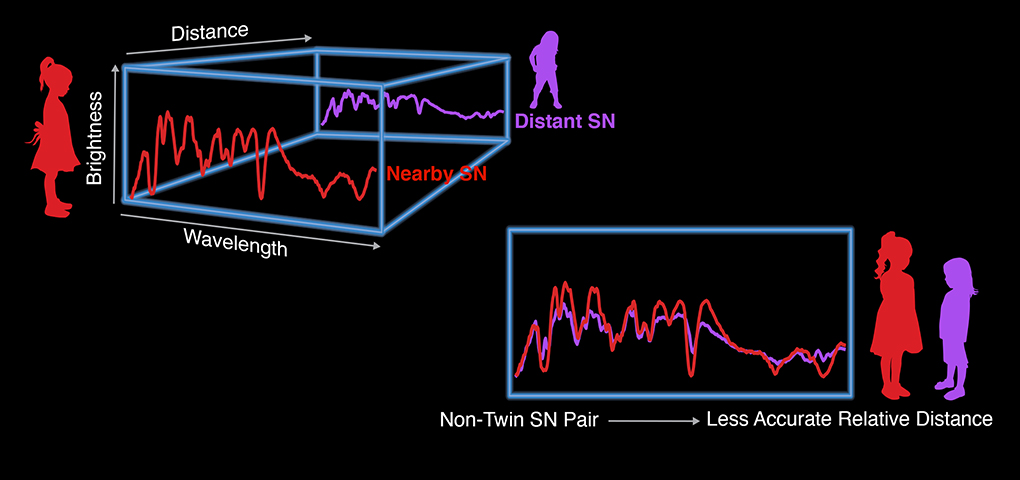Exploring Dark Energy with Supernovae
Type Ia supernovae (SNe Ia) were used to discover the accelerating expansion of the universe, whose cause has been dubbed "dark energy." Due to the lack of viable physical models, the dark energy is studied via its equation of state, w, the ratio of its pressure, P to its energy density, ρ. w is in turn studied in terms of its value at the present epoch, w0, and its derivative with time, wa, with the specific form w(z) = w0 + waz/(1+z) being a solution to the Klein-Gordon relativistic wave equation. The quest of modern cosmology is to measure w0, wa, and two new major telescope facilities, NGRST and the Vera Rubin Observatory's (VRO) Legacy Survey of Space and Time (LSST), have this as one of their key projects. Currently w0 is known to approximately ~ 8% when combining SNe Ia, CMB, and BAO, and wa – whether the dark energy is changing – is known only ~ 25%.
Twins Embedding: Shown are pairs of supernovae – in each case one is nearby and one distant. The ones that line up well – twins – provide much better relative distances. Almost all SNe Ia have many close twins out there in the cosmos. (Graphic credit: Zosia Rostomian/Berkeley Lab; photo credit: NASA/ESA)
Science Objectives:
Measuring the dark energy equation of state by enhancing Roman Space Telescope and Rubin Observatory LSST supernova programs. Separate out the different supernova types, using the SN Ia for cosmology. Double the accuracy and dramatically reduce systematic errors in the measurement of each SN using new standardization techniques, such as "Twins Embedding," that use spectroscopy.
Observable and Measurements:
Spectra of Type Ia supernovae out to redshift 1.7 in rest-frame visible wavelengths in order to classify them and implement Twins Embedding. Roman and/or Rubin will find these SNe in specific fields, to which ORCAS can return each orbit.
Key Functional Requirements:
New Keck spectrograph covering wavelengths 0.5 - 2.0 µm to capture the same spectral features for all high redshift SNe all in one exposure. High-throughput over 3 octaves requires prism disperser. Maximal sky suppression requires a minimum 0.10~arcsec spatial sampling and 0.5 × 0.5 arcsec minimum FoV. Concept of operations will include input from new Rubin and Roman target lists. Minimum of 100 such SNe Ia to check for systematics within larger Rubin and Roman supernova surveys.
ORCAS Uniqueness:
The limiting factor in measuring cosmological supernovae is the brightness of the sky and high efficiency. The AO with Keck+ORCAS will dramatically reduce the sky brightness under the PSF, leading to much higher SNR in a given time. The high Strehl ratio will pack more of the available light into that PSF, leading to much higher efficiency than with Strehl ratios from laser guide stars. The improvement will be dramatic at both visible and infrared wavelengths.


